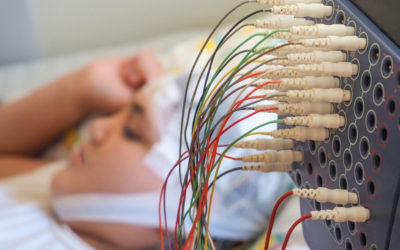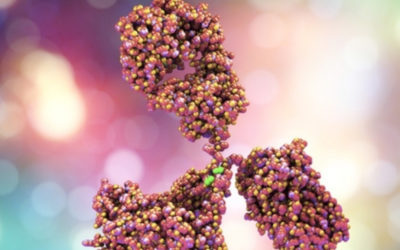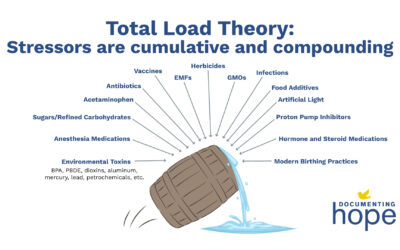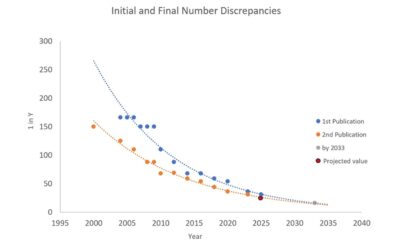Research Results
The Documenting Hope Project is a multi-year research program involving at least two IRB-approved studies. We opened enrollment for our first research study, the CHIRP(TM) Study, in 2018 and continue to enroll participants. Our second study, the FLIGHT(TM) Study opens for enrollment in 2021. As we continue to collect and analyze data we will share new and relevant findings with our community. Be sure to sign up to get the latest findings and research opportunities delivered right to your inbox.
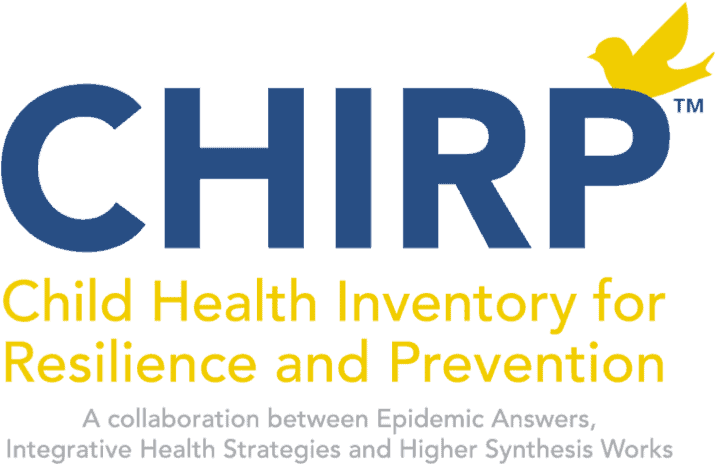
What Is Autism, Really?
Autism is a term that is reasonably new in the modern lexicon. While the term autism was first coined in 1912, a neurological presentation that has similar characteristics to what we call autism has likely been around for a very long time in human history. However,...
Chronic Inflammation: A Key Driver of Chronic Health Conditions
What Is Chronic Inflammation? Chronic inflammation is a hallmark of chronic health conditions, whether it's a neurodevelopmental disorder like autism or ADHD, an autoimmune disorder, a mood disorder, diabetes, allergies, asthma, gastrointestinal disorder, heart...
Seizures Main Info Page
What Are Seizures? Seizures can be a co-morbid condition associated with a disability such as autism, Down syndrome, cerebral palsy or mitochondrial dysfunction, although they also occur in children without any of these conditions. The brain has thousands of neurons,...
Developmental Delays Main Info Page
What Are Developmental Delays? Does your child have developmental delays? Typical delays are: Not rolling over on time Not sitting up unsupported on time Not crawling on time Not walking on time Speech and language delays Skipping a phase (such as not crawling) Never...
Dyspraxia and Apraxia Main Info Page
What Are Dyspraxia and Apraxia? Dyspraxia is the partial loss of the ability to coordinate and perform skilled purposeful movements. Apraxia is the complete loss of this ability. Dyspraxia and apraxia together are called Global Apraxia. The root word “praxia” means...
PANS PANDAS Main Info Page
What Is PANS PANDAS? PANS PANDAS are newer diagnoses that your child's pediatrician or psychiatrist may not be aware of. They are disorders that are loosely defined as a sudden onset of acute anxiety and mood variability accompanied by OCD (Obsessive Compulsive...
Mitochondrial Dysfunction Main Info Page
Symptoms of Mitochondrial Dysfunction The following symptoms may indicate that your child has mitochondrial dysfunction or a problem in energy production: Large motor delays Failure to thrive, growth delays Low muscle tone Extreme fatigue Inability to regulate...
Lyme Disease Main Info Page
What Is Lyme Disease? Lyme disease is a tick-borne illness infectious disease transmitted to humans by a black-legged deer tick; these ticks may carry up to twenty diseases. It was first reported in 1975 in the town of Old Lyme, Connecticut in the United States....
Emotional, Behavioral and Mood Symptoms Main Info Page
Children are increasingly being prescribed pharmaceutical medication to help them deal with emotional and behavioral problems as well as mood symptoms. What Types of Emotional, Behavioral and Mood Symptoms Are Commonly Seen in Our Kids? Depression: May be exhibited as...
Food Sensitivities and Intolerances Main Food Page
Common Symptoms of Food Sensitivities and Intolerances Many children today experience food sensitivities and intolerances that are known to have adverse effects on their mood and behaviors. Unfortunately, when parents see unwanted behaviors, depression or mood swings...
Total Load Theory
What Is Total Load Theory? Total load theory is a conceptual framework used to understand the synergistic and cumulative impact of many environmental and lifestyle stressors on an individual’s health. It posits that each individual stressor adds to the total “load” a...
Autism Spectrum Disorder Main Info Page
What Is Autism Spectrum Disorder? Autism spectrum disorder is a developmental disorder characterized by impairments in sensory, language, social, emotional and behavior areas. It is a “spectrum disorder,” with manifestations ranging from mild to severe. What Your...
Hypotonia and Hypertonia Main Info Page
What Are Hypotonia and Hypertonia? Children with muscle tone disorders usually have either hypotonia or hypertonia. Hypotonia, which means low muscle tone, causes increased flexibility and looseness of the muscles. Hypertonia, which means high or too much muscle tone,...
Sensory Processing Disorder Main Info Page
What Is Sensory Processing Disorder? Children with sensory processing disorder issues have great difficulty processing and acting upon information received through their senses. Have you ever seen a child who appears to be “out of sync” with how they interact with...
Learning Disabilities Main Info Page
What Is a Learning Disability? A learning disability may come in many different shapes and sizes depending on the child. It is not always easy to identify a learning disability in a child, but the time for concern would be if your child consistently struggles over and...
Gastrointestinal Disorders Main Info Page
What Are Gastrointestinal Disorders? Living with gastrointestinal disorders is very painful and distressful for children and heartbreaking for parents, especially when a child has limited language to express how they feel. One thing is certain: the faces of children...
Diabetes and Obesity Main Info Page
What Are Obesity and Diabetes? Michelle Obama, in her capacity as First Lady, launched her “Let’s Move” campaign in 2010 in hopes of bringing awareness as well as solutions to the American silent epidemic of childhood obesity and diabetes. The reality is that...
Allergies Main Info Page
What Are Allergies? Allergies are reactions to foreign substances by the immune system. The body’s defense system responds to foreign invaders or pathogens and this response triggers some form of immediate reaction in the body. Children today experience allergies at a...
Autoimmune Disorders Main Info Page
What Are Autoimmune Disorders? Autoimmune disorders are inflammatory conditions in which antibodies, protein molecules produced by the body's immune system, attack and destroy healthy body tissue. Doctors recognize more than 100 types of autoimmune disorders,...
Attention Deficit Disorders (ADD and ADHD) Main Info Page
What Is Attention Deficit Disorder? Attention deficit disorder is a behavioral condition defined by specific subjective criteria in the latest edition of the Diagnostic and Statistical Manual of the American Psychiatric Association (DSM-V). This book describes three...
Gut Dysbiosis
The Gut – Teaming with Life The gastrointestinal system – or gut - refers to the long hollow tube that stretches from the tip of your tongue right down to your rectum. It is home to trillions of microorganisms, including bacteria and yeast, essential to the most basic...
How the Body Maintains Homeostasis and Optimal Function with Bioregulation
What Is Bioregulation? The human body is a complex and dynamic system designed to maintain stability and function in the face of internal and external changes. This process is known as homeostasis and is essential for survival and well-being. Bioregulation - the...
Using Lab Tests and Assessments to Uncover Root Causes in Children’s Health
When a child is struggling with health or developmental challenges, addressing symptoms alone may not provide lasting relief. To promote true healing and development, it’s important to look for root causes—underlying imbalances in the body that may be contributing to...
Is the Autism Rate 1 in 31? Or Higher?
In an April 10, 2025 press conference, HHS Secretary Robert Kennedy, Jr. provided an update to the CDC’s autism rate of 1 in 36 children. According to the CDC, autism now affects 1 in 31 children in the United States. We predicted that very number! When then CDC came...
What Is Causing the Autism Epidemic?
During an April 10, 2025 Presidential Cabinet meeting, Health and Human Services Secretary Robert F. Kennedy, Jr. indicated that “By September we will know what has caused the autism epidemic.” “And we’ll be able to eliminate those exposures,” Kennedy asserted. If you...
Is Stem Cell Therapy Appropriate for Autism?
Regenerative Medicine and Cellular Therapies Regenerative medicine is a class of medicine geared toward restoring tissue or organs that may have been damaged. “Cellular therapy” is a broad term that refers to treatments that involve the use, modification, or support...
Low-to-No-Cost Detoxification Strategies
In today’s world, our bodies are exposed to a constant stream of toxins from food, air, water, and even household products. Detoxification, or detox, is the process of helping your body eliminate these harmful substances along with the body’s own internally generated...
Supporting Picky Eaters Using a No-Pressure Approach
Looking at the Root Causes of Picky Eating To know how to best support your child with complex picky eating and feeding challenges, it’s important to understand what may be contributing. Parenting a child who struggles with eating can be overwhelming, especially when...
Biomedical and Physiological Imbalances Commonly Seen in Autism
Biomedical and Physiological Imbalances Commonly Seen in Autism Autism is a subjective diagnostic label that covers a cluster of symptoms or stereotypical behaviors. While conventional medicine often describes autism as a predominately genetic condition that results...
Foundations of Health
What Are the Foundations of Health? When facing a complex chronic health or developmental condition, it's easy to fall into the mindset that only something highly sophisticated—like stem cell therapy or a cutting-edge biologic drug—holds the key to healing. This is...
Metabolism: The Hidden Engine of a Child’s Health
What Is Metabolism? In today’s modern world, our understanding of children’s health must evolve beyond simply managing symptoms. For children with chronic health conditions and developmental challenges—including those on the autism spectrum—it is especially important...
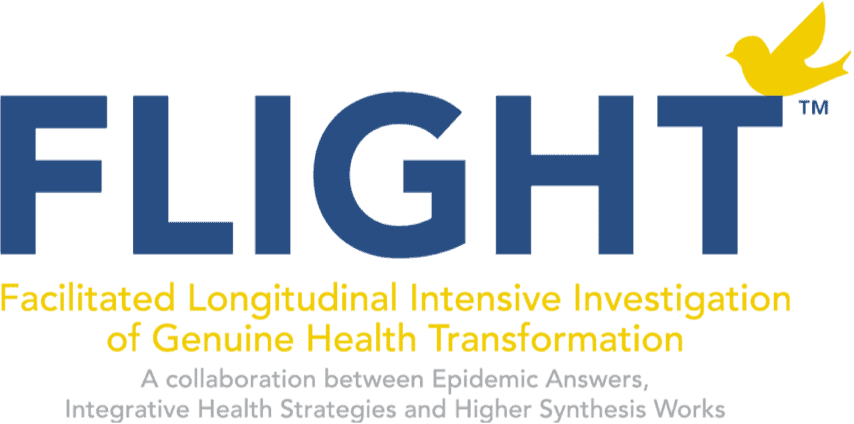
What Is Autism, Really?
Autism is a term that is reasonably new in the modern lexicon. While the term autism was first coined in 1912, a neurological presentation that has similar characteristics to what we call autism has likely been around for a very long time in human history. However,...
Chronic Inflammation: A Key Driver of Chronic Health Conditions
What Is Chronic Inflammation? Chronic inflammation is a hallmark of chronic health conditions, whether it's a neurodevelopmental disorder like autism or ADHD, an autoimmune disorder, a mood disorder, diabetes, allergies, asthma, gastrointestinal disorder, heart...
Seizures Main Info Page
What Are Seizures? Seizures can be a co-morbid condition associated with a disability such as autism, Down syndrome, cerebral palsy or mitochondrial dysfunction, although they also occur in children without any of these conditions. The brain has thousands of neurons,...
Developmental Delays Main Info Page
What Are Developmental Delays? Does your child have developmental delays? Typical delays are: Not rolling over on time Not sitting up unsupported on time Not crawling on time Not walking on time Speech and language delays Skipping a phase (such as not crawling) Never...
Dyspraxia and Apraxia Main Info Page
What Are Dyspraxia and Apraxia? Dyspraxia is the partial loss of the ability to coordinate and perform skilled purposeful movements. Apraxia is the complete loss of this ability. Dyspraxia and apraxia together are called Global Apraxia. The root word “praxia” means...
PANS PANDAS Main Info Page
What Is PANS PANDAS? PANS PANDAS are newer diagnoses that your child's pediatrician or psychiatrist may not be aware of. They are disorders that are loosely defined as a sudden onset of acute anxiety and mood variability accompanied by OCD (Obsessive Compulsive...
Mitochondrial Dysfunction Main Info Page
Symptoms of Mitochondrial Dysfunction The following symptoms may indicate that your child has mitochondrial dysfunction or a problem in energy production: Large motor delays Failure to thrive, growth delays Low muscle tone Extreme fatigue Inability to regulate...
Lyme Disease Main Info Page
What Is Lyme Disease? Lyme disease is a tick-borne illness infectious disease transmitted to humans by a black-legged deer tick; these ticks may carry up to twenty diseases. It was first reported in 1975 in the town of Old Lyme, Connecticut in the United States....
Emotional, Behavioral and Mood Symptoms Main Info Page
Children are increasingly being prescribed pharmaceutical medication to help them deal with emotional and behavioral problems as well as mood symptoms. What Types of Emotional, Behavioral and Mood Symptoms Are Commonly Seen in Our Kids? Depression: May be exhibited as...
Food Sensitivities and Intolerances Main Food Page
Common Symptoms of Food Sensitivities and Intolerances Many children today experience food sensitivities and intolerances that are known to have adverse effects on their mood and behaviors. Unfortunately, when parents see unwanted behaviors, depression or mood swings...
Total Load Theory
What Is Total Load Theory? Total load theory is a conceptual framework used to understand the synergistic and cumulative impact of many environmental and lifestyle stressors on an individual’s health. It posits that each individual stressor adds to the total “load” a...
Autism Spectrum Disorder Main Info Page
What Is Autism Spectrum Disorder? Autism spectrum disorder is a developmental disorder characterized by impairments in sensory, language, social, emotional and behavior areas. It is a “spectrum disorder,” with manifestations ranging from mild to severe. What Your...
Hypotonia and Hypertonia Main Info Page
What Are Hypotonia and Hypertonia? Children with muscle tone disorders usually have either hypotonia or hypertonia. Hypotonia, which means low muscle tone, causes increased flexibility and looseness of the muscles. Hypertonia, which means high or too much muscle tone,...
Sensory Processing Disorder Main Info Page
What Is Sensory Processing Disorder? Children with sensory processing disorder issues have great difficulty processing and acting upon information received through their senses. Have you ever seen a child who appears to be “out of sync” with how they interact with...
Learning Disabilities Main Info Page
What Is a Learning Disability? A learning disability may come in many different shapes and sizes depending on the child. It is not always easy to identify a learning disability in a child, but the time for concern would be if your child consistently struggles over and...
Gastrointestinal Disorders Main Info Page
What Are Gastrointestinal Disorders? Living with gastrointestinal disorders is very painful and distressful for children and heartbreaking for parents, especially when a child has limited language to express how they feel. One thing is certain: the faces of children...
Diabetes and Obesity Main Info Page
What Are Obesity and Diabetes? Michelle Obama, in her capacity as First Lady, launched her “Let’s Move” campaign in 2010 in hopes of bringing awareness as well as solutions to the American silent epidemic of childhood obesity and diabetes. The reality is that...
Allergies Main Info Page
What Are Allergies? Allergies are reactions to foreign substances by the immune system. The body’s defense system responds to foreign invaders or pathogens and this response triggers some form of immediate reaction in the body. Children today experience allergies at a...
Autoimmune Disorders Main Info Page
What Are Autoimmune Disorders? Autoimmune disorders are inflammatory conditions in which antibodies, protein molecules produced by the body's immune system, attack and destroy healthy body tissue. Doctors recognize more than 100 types of autoimmune disorders,...
Attention Deficit Disorders (ADD and ADHD) Main Info Page
What Is Attention Deficit Disorder? Attention deficit disorder is a behavioral condition defined by specific subjective criteria in the latest edition of the Diagnostic and Statistical Manual of the American Psychiatric Association (DSM-V). This book describes three...
Gut Dysbiosis
The Gut – Teaming with Life The gastrointestinal system – or gut - refers to the long hollow tube that stretches from the tip of your tongue right down to your rectum. It is home to trillions of microorganisms, including bacteria and yeast, essential to the most basic...
How the Body Maintains Homeostasis and Optimal Function with Bioregulation
What Is Bioregulation? The human body is a complex and dynamic system designed to maintain stability and function in the face of internal and external changes. This process is known as homeostasis and is essential for survival and well-being. Bioregulation - the...
Using Lab Tests and Assessments to Uncover Root Causes in Children’s Health
When a child is struggling with health or developmental challenges, addressing symptoms alone may not provide lasting relief. To promote true healing and development, it’s important to look for root causes—underlying imbalances in the body that may be contributing to...
Is the Autism Rate 1 in 31? Or Higher?
In an April 10, 2025 press conference, HHS Secretary Robert Kennedy, Jr. provided an update to the CDC’s autism rate of 1 in 36 children. According to the CDC, autism now affects 1 in 31 children in the United States. We predicted that very number! When then CDC came...
What Is Causing the Autism Epidemic?
During an April 10, 2025 Presidential Cabinet meeting, Health and Human Services Secretary Robert F. Kennedy, Jr. indicated that “By September we will know what has caused the autism epidemic.” “And we’ll be able to eliminate those exposures,” Kennedy asserted. If you...
Is Stem Cell Therapy Appropriate for Autism?
Regenerative Medicine and Cellular Therapies Regenerative medicine is a class of medicine geared toward restoring tissue or organs that may have been damaged. “Cellular therapy” is a broad term that refers to treatments that involve the use, modification, or support...
Low-to-No-Cost Detoxification Strategies
In today’s world, our bodies are exposed to a constant stream of toxins from food, air, water, and even household products. Detoxification, or detox, is the process of helping your body eliminate these harmful substances along with the body’s own internally generated...
Supporting Picky Eaters Using a No-Pressure Approach
Looking at the Root Causes of Picky Eating To know how to best support your child with complex picky eating and feeding challenges, it’s important to understand what may be contributing. Parenting a child who struggles with eating can be overwhelming, especially when...
Biomedical and Physiological Imbalances Commonly Seen in Autism
Biomedical and Physiological Imbalances Commonly Seen in Autism Autism is a subjective diagnostic label that covers a cluster of symptoms or stereotypical behaviors. While conventional medicine often describes autism as a predominately genetic condition that results...
Foundations of Health
What Are the Foundations of Health? When facing a complex chronic health or developmental condition, it's easy to fall into the mindset that only something highly sophisticated—like stem cell therapy or a cutting-edge biologic drug—holds the key to healing. This is...
Metabolism: The Hidden Engine of a Child’s Health
What Is Metabolism? In today’s modern world, our understanding of children’s health must evolve beyond simply managing symptoms. For children with chronic health conditions and developmental challenges—including those on the autism spectrum—it is especially important...



